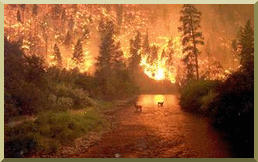
DROUGHT FACTS
The Ojos Negros Research Group
| 2. IMPACTS OF DROUGHT |
|
Drought produces a complex web of impacts that spans many sectors of the economy
and reaches well beyond the
area experiencing physical drought. This complexity exists because water is integral
to society's ability to produce goods and provide services.
Impacts are commonly referred to as direct and indirect. Direct impacts include reduced crop, rangeland, and forest productivity, increased fire hazard, reduced water levels, increased livestock and wildlife mortality rates, and damage to wildlife and fish habitat. The consequences of these direct impacts illustrate indirect impacts. For example, a reduction in crop, rangeland, and forest productivity may result in reduced income for farmers and agribusiness, increased prices for food and timber, unemployment, reduced tax revenues because of reduced expenditures, foreclosures on bank loans to farmers and businesses, migration, and disaster relief programs. The types of drought impacts are described below.
Many economic impacts occur in agriculture and related sectors, because of the reliance of these sectors on surface and groundwater supplies. In addition to losses in yields in both crop and livestock production, drought is associated with insect infestations, plant disease, and wind erosion. The incidence of forest and range fires increases substantially during extended periods of droughts, which in turn places both human and wildlife populations at higher levels of risk. Income loss is another indicator used in assessing the impacts of drought. Reduced income for farmers has a ripple effect. Retailers and others who provide goods and services to farmers face reduced business. This leads to unemployment, increased credit risk for financial institutions, capital shortfalls, and eventual loss of tax revenue for local, state, and federal governments. Prices for food, energy, and other products increase as supplies are reduced. In some cases, local shortages of certain goods result in importing these goods from outside the drought-stricken region. Reduced water supply impairs the navigability of rivers and results in increased transportation costs because products must be transported by alternative means. Hydropower production may also be significantly affected.
Environmental losses are the result of damages to plant and animal species, wildlife habitat, and air and water quality, forest and range fires, degradation of landscape quality, loss of biodiversity, and soil erosion. Some of these effects are short-term, conditions returning to normal following the end of the drought. Other environmental effects last for some time and may even become permanent. Wildlife habitat, for example, may be degraded through the loss of wetlands, lakes, and vegetation. However, many species eventually recover from this temporary aberration. The degradation of landscape quality, including increased soil erosion, may lead to a more permanent loss of biological productivity.
Social impacts involve public safety, health, conflicts between water users, reduced quality of life, and inequities in the distribution of impacts and disaster relief. Many of the impacts identified as economic and environmental have social components as well. Population migration is a significant problem in many countries, often stimulated by a greater supply of food and water elsewhere. Migration is usually to urban areas within the stressed area, or to regions outside the drought area. Migration may even be to adjacent countries. When the drought has abated, the migrants seldom return home, depriving rural areas of valuable human resources. The drought migrants place increasing pressure on the social infrastructure of the urban areas, leading to increased poverty and social unrest. |
| Definition of Drought | Characteristics of Drought | Drought Mitigation |
| Strategies for the Ojos Negros Valley | Summary | Drought Facts |
| http://ponce.sdsu.edu/three_issues_droughtfacts02.html | 021104 |